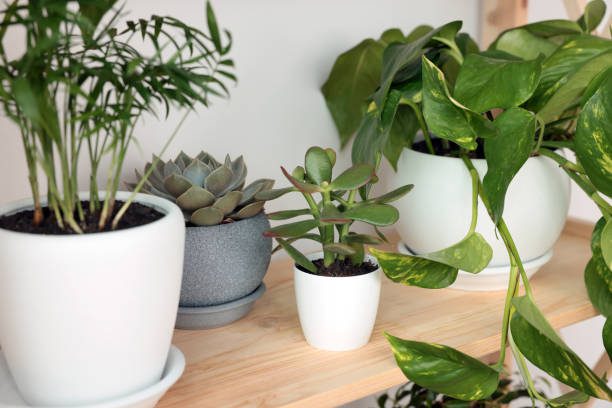Indoor gardening is a delightful and rewarding hobby that allows you to bring the beauty of nature inside your home. However, just like outdoor gardening, it comes with its fair share of challenges. In this blog, we will explore 12 common problems faced by indoor gardeners, along with practical prevention, treatment, and solutions to help you maintain a thriving indoor garden. Let’s dive in!
Insufficient Light
Problem:
One of the most common challenges in indoor gardening is providing adequate light for plants, especially in spaces with limited natural sunlight.
Prevention:
Choose indoor plants that thrive in low-light conditions, such as pothos, snake plants, and peace lilies.
Position plants near windows with indirect sunlight or invest in grow lights for areas with poor lighting.
Treatment:
Rotate plants regularly to ensure all sides receive equal light exposure.
Trim away yellowing leaves or leggy growth to encourage healthy new growth.
Overwatering
Problem:
Overwatering is a common mistake among indoor gardeners, leading to root rot and other fungal diseases.
Prevention:
Research each plant’s specific watering needs and create a watering schedule accordingly.
Use well-draining pots and potting mixtures to prevent water from accumulating at the bottom.
Treatment:
Allow the soil to dry out between waterings and adjust the watering frequency accordingly.
If signs of overwatering appear, repot the plant with fresh, well-draining soil.
Underwatering
Problem:
On the flip side, underwatering can cause wilting, stunted growth, and nutrient deficiencies in indoor plants.
Prevention:
Monitor plant moisture levels regularly, especially during hot and dry seasons.
Group plants with similar watering requirements together to simplify care.
Treatment:
Water the plant thoroughly and consistently until excess water drains from the bottom of the pot.
Consider using self-watering systems or hydrogel crystals to help maintain consistent soil moisture.
Poor Air Circulation
Problem:
Stagnant air can lead to mold growth, pest infestations, and hinder plant growth.
Prevention:
Place fans strategically to improve air circulation within your indoor garden space.
Regularly open windows and doors to allow fresh air to flow into the room.
Treatment:
Gently wipe plant leaves to remove dust and improve their ability to absorb CO2 and sunlight.
Consider using a natural fungicide or neem oil spray for plant to combat mold and pests.
Pests
Problem:
Indoor plants are susceptible to pests such as aphids, mealybugs, and spider mites.
Prevention:
Inspect new plants before introducing them into your indoor garden to avoid bringing pests home.
Quarantine new plants for a few weeks to monitor for any signs of infestations.
Treatment:
Isolate infected plants to prevent the pests from spreading to others.
Introduce natural predators like ladybugs or use eco-friendly insecticidal soap to control the pest population.
Temperature Fluctuations
Problem:
Indoor plants can suffer from temperature stress due to inconsistent indoor temperatures.
Prevention:
Place plants away from drafty areas and heating or cooling vents.
Use a thermometer to monitor temperature variations and adjust as needed.
Treatment:
Move affected plants to more stable temperature zones within your home.
Use a heating mat during colder months to provide consistent warmth to your plants’ roots.
Nutrient Deficiencies
Problem:
Inadequate nutrients can lead to yellowing leaves, stunted growth, and poor flowering.
Prevention:
Choose a balanced indoor plant fertilizer and follow the recommended dosage.
Repot plants annually with fresh potting mix to replenish nutrients.
Treatment:
Apply a diluted liquid fertilizer to address specific nutrient deficiencies.
Incorporate compost or organic matter into the soil to improve nutrient content.
Rootbound Plants
Problem:
Over time, indoor plants can outgrow their pots, becoming rootbound and hindering their growth.
Prevention:
Repot plants when they outgrow their containers or show signs of being rootbound.
Choose pots with adequate drainage and enough space for root expansion.
Treatment:
Gently loosen the plant’s root ball before repotting it into a larger container.
Trim any unhealthy or excessively long roots during the repotting process.
pH Imbalance
Problem:
Incorrect pH levels can impede nutrient absorption and overall plant health.
Prevention:
Use a pH meter to test the soil regularly and adjust it to the appropriate range for your plants.
Avoid using hard water, which can raise the soil’s pH.
Treatment:
Add soil amendments like lime or sulfur to correct pH imbalances.
Use pH-adjusted water when watering your plants.
Inadequate Humidity
Problem:
Low humidity levels can lead to dry and withered leaves, especially in tropical plants.
Prevention:
Group plants together to create a microclimate with higher humidity levels.
Place a humidity tray filled with water and pebbles beneath the pots to increase humidity.
Treatment:
Mist the leaves regularly to provide a quick boost in humidity.
Invest in a room humidifier to maintain consistent humidity levels.
Improper Pruning
Problem:
Incorrect pruning can harm your indoor plants and hinder their growth.
Prevention:
Learn the proper pruning techniques for each plant type to ensure healthy growth.
Sterilize pruning tools before use to avoid spreading diseases.
Treatment:
Trim back dead or diseased plant parts to encourage new growth.
Train the plant’s growth using gentle bending and pinching techniques.
Plant Diseases
Problem:
Indoor plants are susceptible to various diseases caused by fungi, bacteria, or viruses.
Prevention:
Keep your indoor garden clean and free of debris to minimize disease risks.
Ensure good air circulation and avoid overcrowding plants.
Treatment:
Isolate infected plants to prevent the spread of diseases.
Use appropriate fungicides or bactericides to treat specific diseases.
Conclusion
Indoor gardening offers numerous benefits, but it also comes with its set of challenges. By understanding and addressing these 12 common problems, you can create a healthy and thriving indoor garden. Remember to choose the right plants for your space, provide adequate light and water, maintain proper humidity levels, and be vigilant about pests and diseases and natural indoor plant care products. With care and dedication, you’ll soon enjoy the beauty of a lush and vibrant indoor garden that enhances your living space and brings you joy year-round. Happy gardening!
